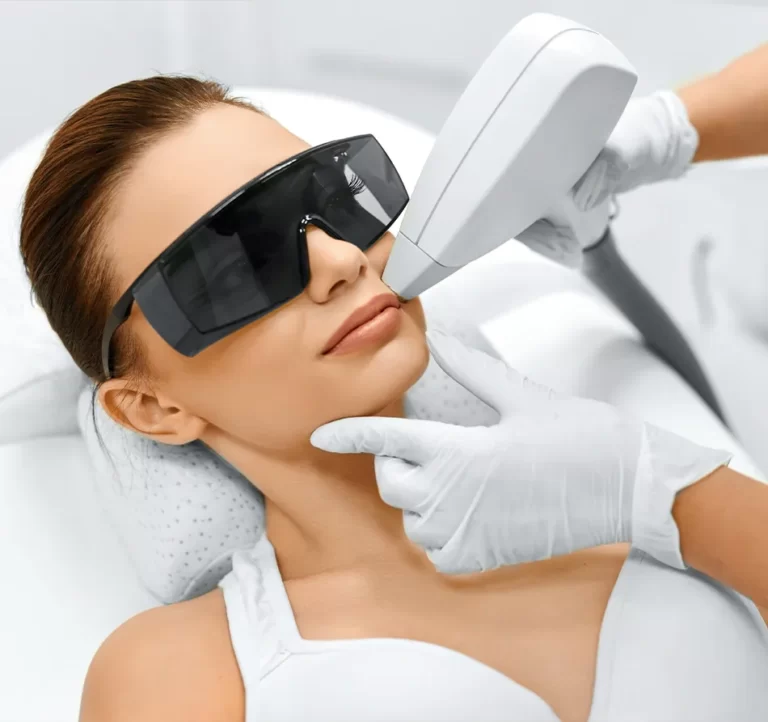
Laser Hair Reduction
Conscious of body hair in public and would like to change how you feel?
Laser hair reduction
Laser hair removal is a medical procedure that uses a concentrated beam of light (laser) to remove unwanted hair.
During laser hair removal, a laser emits a light that is absorbed by the pigment (melanin) in the hair. The light energy is converted to heat, which damages the tube-shaped sacs within the skin (hair follicles) that produce hairs. This damage inhibits or delays future hair growth.
Laser hair removal is most effective for people who have light skin and dark hair, but it can be successfully used on all skin types.
Why its done
Laser hair removal is used to reduce unwanted hair. Common treatment locations include legs, armpits, upper lip, chin and the bikini line. However, it’s possible to treat unwanted hair in nearly any area, except the eyelid or surrounding area. Skin with tattoos should not be treated either.
Hair color and skin type influence the success of laser hair removal. The basic principle is that the pigment of the hair, but not the pigment of the skin, should absorb the light. The laser should damage only the hair follicle while avoiding damage to the skin. Therefore, a contrast between hair and skin color — dark hair and light skin — results in the best outcomes.
The risk of damage to skin is greater when there is little contrast between hair and skin color, but advances in laser technology have made laser hair removal an option for people who have darker skin. Laser hair removal is less effective for hair colors that don’t absorb light well: gray, red, blond and white. However, laser treatment options for light-colored hair continue to be developed.

Risks
Risks of side effects vary with skin type, hair color, treatment plan and adherence to pre-treatment and post-treatment care. The most common side effects of laser hair removal include:
- Skin irritation. Temporary discomfort, redness and swelling are possible after laser hair removal. Any signs and symptoms typically disappear within several hours.
- Pigment changes. Laser hair removal might darken or lighten the affected skin. These changes might be temporary or permanent. Skin lightening primarily affects those who don’t avoid sun exposure before or after treatment and those who have darker skin.
Rarely, laser hair removal can cause blistering, crusting, scarring or other changes in skin texture. Other rare side effects include graying of treated hair or excessive hair growth around treated areas, particularly on darker skin.
Laser hair removal isn’t recommended for eyelids, eyebrows or surrounding areas, due to the possibility of severe eye injury.


Treatment
Laser hair removal is used more frequently nowadays to help remove hair long term. As the technology has improved, this service has become more moderately priced for the average citizen, and several different methods have been developed.
The type of laser treatment you end up getting will be based on your own specific profile – mostly, what tone is your skin and what is your hair like. These characteristics are important for choosing the laser that will be the most effective on your hair.
There is a level of skill involved in performing laser hair removal treatments. The laser technician’s experience may also dictate how many sessions you have to go for, how much discomfort you feel, and how long each session takes.
Type #1: Alexandrite Laser Hair Removal
Alexandrite laser are often used during the removal of tattoos and pigmentation disorders. However, the main application field is the permanent hair removal*. Here a wavelength of 755nm is used. The colour pigments in the hair root absorb the emitted bundled light. Due to its high energy the hair root is destroyed and the regrowth of a new hair is prevented. This way a permanent* result can be achieved. The treatment is, thanks to its innovative cooling system.
Type #2: Diode Laser Hair Removal
Diode laser eliminates unwanted hair by emitting beam of light that is absorbed by the pigment in the hair i.e melanin. The energy of the laser is concentrated in the hair shaft, effectively destroying it without affecting the surrounding skin. Diode laser is the most effective of all laser wavelengths for hair reduction.Diode laser can remove hair from all parts of the body including the face, neck, arms, underarms, abdomen, back and legs. Diode laser can also treat sensitive areas like chest and bikini lines.
Type #3: Ruby Laser Hair Removal
- Light pulses target the hair follicle causing the hair to fall out and minimising further growth.
- The percentage of hairs removed per session varies by location on the body, with thinner-skinned areas (eg armpits and bikini area) generally responding better than thick-skinned areas (eg back and chin).
- In general, 3 or more treatments are required to achieve permanent hair growth reduction.
- Treatments are repeated every 4 to 8 weeks
After the treatment, you may experience some side effects. However, these side effects are not permanent, and are almost never serious. Using a cold compress and moisturizing will alleviate the discomfort and will make the effects go away faster.
Side effects of laser hair removal can include swelling, soreness similar to the feeling of a sunburn, and redness on the treatment area. Not everyone will experience these side effects, and some people will react differently to different lasers. Because darker skin absorbs light more easily, individuals with darker skin are more prone to experiencing burning as a side effect, however using the right laser is key to avoiding this.

Type #4: Nd and LP Nd: YAG
This is a heavy-duty laser. It works best on thicker and courser hair. It is also the best Type for individuals who have darker skin. In fact, it is less effective for individuals with lighter skin and finer hair, so those people should opt for a different laser treatment. Of any type of laser treatment, Nd and LP Nd: YAG treatments have the longest wavelength, which means they tend to be a bit more uncomfortable than other types.
The different types of lasers also dictate the likeliness that the treatment will be permanent. For instance, the Nd and LP Nd: YAG lasers have the longest wavelength, which means they penetrate the deepest. These lasers are more likely to reach the absolute bottom of the root of the hair, and kill it permanently after several sessions.
Type #5: IPL (Intense Pulsed Light)
IPL stands for Intense Pulsed Light technology. Home IPL hair removal devices apply very gentle pulses of light to the hair root. This makes the hair go into its resting phase: the hair you have falls out, and gradually your body grows less hair in that area.
That smoothness lasts a long time, too. The result of 14 years of research, Philips Lumea Prestige delivers a whopping 8 whole weeks of freedom from hair after the first four treatments*. It’s not just for legs either: smart curved attachments allow you to reach and safely treat your underarms, bikini area and face. So IPL really can take the place of shavers, wax treatments or epilators.
